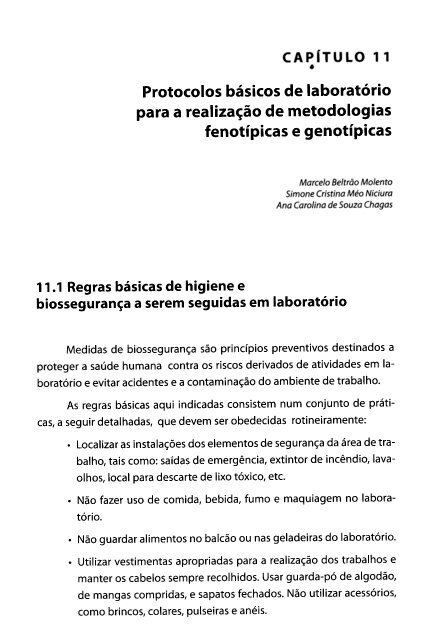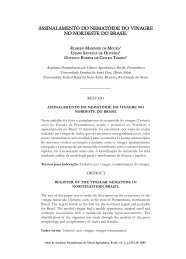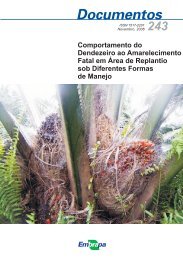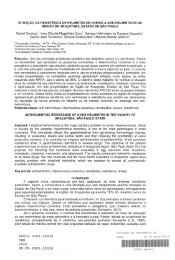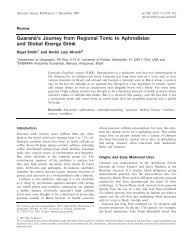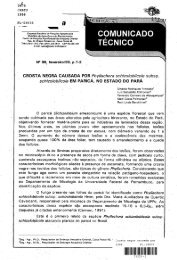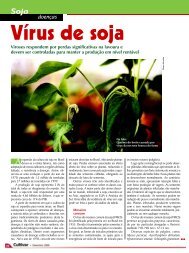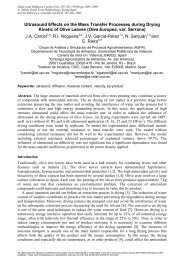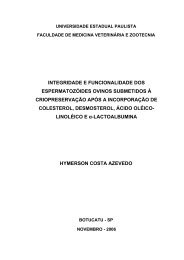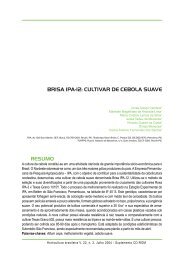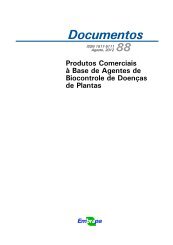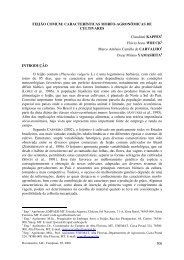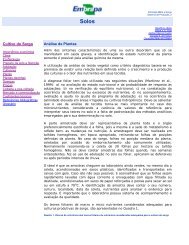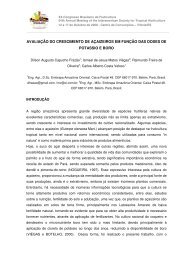Protocolos basicos de laboratorio para a realiza~ao de ... - Embrapa
Protocolos basicos de laboratorio para a realiza~ao de ... - Embrapa
Protocolos basicos de laboratorio para a realiza~ao de ... - Embrapa
Create successful ePaper yourself
Turn your PDF publications into a flip-book with our unique Google optimized e-Paper software.
. CAPiTULO 11<br />
<strong>Protocolos</strong> <strong>basicos</strong> <strong>de</strong> <strong>laboratorio</strong><br />
<strong>para</strong> a <strong>realiza~ao</strong> <strong>de</strong> metodologias<br />
fenotipicas e genotipicas<br />
Marcelo Beltrao Molento<br />
Simone Cristina Meo Niciura<br />
Ana Carolina <strong>de</strong> Souza Chagas<br />
11.1 Regras basicas <strong>de</strong> higiene e<br />
biosseguran~a a serem seguidas em <strong>laboratorio</strong><br />
Medidas <strong>de</strong> biosseguran
118<br />
.Manter limpo 0 ambiente.<br />
MANUALPRATICO<br />
Metodologias <strong>de</strong> diagn6stico da resistencia e <strong>de</strong><br />
<strong>de</strong>tec~ao <strong>de</strong> substancias ativas em <strong>para</strong>sias <strong>de</strong> ruminantes<br />
.Lavar as maos cuidadosamente, <strong>de</strong>pois <strong>de</strong> qualquer manipulac;:ao e<br />
antes <strong>de</strong> se retirar do laborat6rio. Antes <strong>de</strong> sair, <strong>de</strong>ixar 0 guarda-p6<br />
no laborat6rio.<br />
.Utilizar luvas apropriadas <strong>para</strong> evitar cantata com substancias qui.<br />
micas ou material bio/6gico. Nao tocar em objetos (telefones, lapi-<br />
seiras, portas, ca<strong>de</strong>rnos, etc.) se as luvas estiverem contaminadas.<br />
.Proteger os olhos e 0 rosto <strong>de</strong> respingos ou <strong>de</strong> impactos, usando<br />
6culos <strong>de</strong> prote
Capitulo 11 Protocol os <strong>basicos</strong> <strong>de</strong> <strong>laboratorio</strong> <strong>para</strong> a <strong>realiza~ao</strong> <strong>de</strong> metodologias...<br />
119<br />
em gela<strong>de</strong>ira, a 4 o( (jamais congeladas), <strong>de</strong>ntro <strong>de</strong> sacos <strong>de</strong> plastico bem<br />
lacrados e <strong>de</strong>vidamente i<strong>de</strong>ntificados.<br />
Ha uma Dutra op
MANUAL PRATICO<br />
Metodologias <strong>de</strong> diagnostico da resistencia e <strong>de</strong><br />
<strong>de</strong>tec~ao <strong>de</strong> substancias ativas em p'¥asitas <strong>de</strong> ruminantes<br />
.Contar todos os avos contidos nas duas celulas, incluindo aqueles<br />
.."+;~,",r ~~r I:~h~~<br />
Camara McMaster: a camara McMaster apresenta duas celulas <strong>de</strong><br />
contagem, tendo, cada uma, altura <strong>de</strong> 0,15 cm e area <strong>de</strong> 1,0 cm2, a volume<br />
<strong>de</strong> Ifquido encontrado em cada celula e obtido pela formula: area x profun-<br />
dida<strong>de</strong> = volume. a numero <strong>de</strong> avos contados nas duas celulas da camara<br />
McMaster <strong>de</strong>ve ser multiplicado par 25. Essa medida visa aumentar 0 grau<br />
<strong>de</strong> confiabilida<strong>de</strong> da tecnica. Para alcanc;:ar major precisao, 0 executor po<strong>de</strong><br />
contar duas camaras McMaster (quatro celulas) e multiplicar a soma final<br />
~~.1'"<br />
Significado da contagem <strong>de</strong> ovos por grama <strong>de</strong> fezes (OPG): a<br />
contagem <strong>de</strong> avos (Figura 1) e apenas um dos indicadores <strong>de</strong> infec
Capitulo 11 <strong>Protocolos</strong> <strong>basicos</strong> <strong>de</strong> <strong>laboratorio</strong> <strong>para</strong> a <strong>realiza~ao</strong> <strong>de</strong> metodologia$<br />
12<br />
Figura 2. Imagens <strong>de</strong> ovos e oocistos <strong>de</strong> <strong>para</strong>sitas gastrintestinais <strong>de</strong> ovinos: ovos da familia TI<br />
chostrongylidae (A); ovo <strong>de</strong> Strongyloi<strong>de</strong>s spp. (8); ovo <strong>de</strong> Moniezia spp. (C); e oocisto <strong>de</strong> Eimer<br />
spp. (0).<br />
11.3 Cultura <strong>de</strong> larvas <strong>de</strong> estrongilr<strong>de</strong>o:<br />
Objetivo: proporcionar urn rneio apropriado <strong>para</strong> prornover a eclo<br />
sac dos avos e a evolu
122<br />
MANUAL PRATICO<br />
Metodologias <strong>de</strong> diagnostico da resistencia e <strong>de</strong><br />
<strong>de</strong>tec~ao <strong>de</strong> substancias ativas em <strong>para</strong>5jtas <strong>de</strong> ruminantes<br />
.Adicionar agua <strong>para</strong> umidificar a mistura, com acumulo <strong>de</strong> 1 cm<br />
<strong>de</strong> agua no fundo do frasco. A mistura <strong>de</strong>ve se apresentar mais ou<br />
menos aerada.<br />
.Cobrir 0 frasco com uma placa <strong>de</strong> Petri ou com a propria tampa<br />
do frasco, mas <strong>de</strong>ixando-a so Ita; e adicionar urn tio largo <strong>de</strong> algo-<br />
daD ou barbante <strong>para</strong> permitir a aera~ao. Colocar 0 frasco em estu-<br />
fa B.O.D. par 7 dias, em temperatura <strong>de</strong> aproximadamente 28 °C e<br />
umida<strong>de</strong> acima <strong>de</strong> 60%. 0 cultivo pod era ocorrer em temperatura<br />
ambiente acima <strong>de</strong> 18 °C, durante 10 a 15 dias. E comum a presen~a<br />
<strong>de</strong> fungos, que nao prejudicam 0 <strong>de</strong>senvolvimento das larvas.<br />
.Avaliar a umida<strong>de</strong> a cada 2 dias e, caso necessaria, borrifar agua ate<br />
a superficie adquirir urn aspecto brilhante.<br />
.Retirar 0 frasco da B.O.D. ap6s 7 dias e enche-io completamente<br />
com agua morna, ou diretamente retirada da torneira se estiver em<br />
regiao <strong>de</strong> clima quente, <strong>para</strong> estimular a migra
Capitulo 11 <strong>Protocolos</strong> <strong>basicos</strong> <strong>de</strong> <strong>laboratorio</strong> <strong>para</strong> a <strong>realiza~ao</strong> <strong>de</strong> metodologias.<br />
123<br />
.As publicac;6es cientfficas requerem que sejam i<strong>de</strong>ntfficadas <strong>de</strong> 50<br />
a 100 larvas par amostra <strong>de</strong> pool <strong>de</strong> grupos experimentais (trata-<br />
menta).<br />
.As larvas obtidas ap6s a coprocultura po<strong>de</strong>m ser armazenadas em<br />
aQua ou em alcool70 °GL, em microtubos <strong>de</strong> 1,5 mL, a 4°(, ou po-<br />
<strong>de</strong>m ser congeladas a -20 o( ou -80 o( <strong>para</strong> a realiza
124<br />
MANUAL PRATICO<br />
Metodologias <strong>de</strong> diagn6stico da resistencia e <strong>de</strong><br />
<strong>de</strong>tec~ao <strong>de</strong> substancias ativas em <strong>para</strong>~tas <strong>de</strong> ruminantes<br />
Tabela 1. Chave <strong>de</strong> i<strong>de</strong>ntifical;:8o <strong>de</strong> larvas <strong>de</strong> nematodas gastrintestinais e pulmonares<br />
que afetam pequenos ruminantes.<br />
2<br />
Bainha da cauda ausente ou nao obtusa<br />
Esofago gem bulbo<br />
Esofago rabditiforme (bulbo duplo)<br />
4 Helminto se cora sob soluc;:ao <strong>de</strong> iodo, ganhando uma cor<br />
mais ou menos uniforme, marrom-escura. Esofago < 40% do<br />
comprimento do helminto e rabditiforme (bulbo duplo); larva<br />
grossa, com extremida<strong>de</strong>s retangulares e cauda longa. que<br />
sugere uma bainha; ponta da cabec;:a abrupta, <strong>de</strong>snivelada<br />
e plana<br />
6<br />
Bainha da cauda ausente au naa abtusa<br />
Bainha da cauda praeminente<br />
Esofago < 30% do corpo da larva; bainha da cauda invisivel<br />
e < 0,5x; larva pequena e letargica, com protuberancia na<br />
cabe9a; cauda termina suave, com ponta arredondada<br />
Es6fago > 40% do corpo da larva<br />
Comprimento do corpo < 500 IJm; diametro < O,7x<br />
Comprimento do corpo < 520 IJm; diametro > 1,Ox<br />
8 Bainha da cauda ausente; es6fago 40% do total do<br />
comprimento da larva e gem 0 bulbo; diametro da larva> 1,Ox;<br />
cabeya em forma <strong>de</strong> bala; cauda robusta, como se a bainha<br />
estivesse quebrada ou perdida. Examinar com cuidado, <strong>para</strong><br />
conferir, com precisao, se a larva apresenta bainha<br />
3<br />
4<br />
Nematoda <strong>de</strong> vida<br />
livre<br />
7<br />
8<br />
2<br />
9<br />
Dictyocaulus filaria<br />
Strongyloi<strong>de</strong>s<br />
Continua...
Capitulo 11 Protocol os <strong>basicos</strong> <strong>de</strong> <strong>laboratorio</strong> <strong>para</strong> a <strong>realiza~ao</strong> <strong>de</strong> metodologias...<br />
Tabela 1. Continuagao.<br />
10<br />
Toda a larva se cora uniformemente, tomando a cor marromescura,<br />
sob solu9ao <strong>de</strong> iodo; esofago com um bulbo<br />
proeminente caudal (proeminente em larva viva e ativa, mas<br />
dificil <strong>de</strong> se ver em larva corada); cabe9a em forma <strong>de</strong> bala<br />
Bainha da cauda 3,5x, com filamento 40% da bainha da<br />
cauda; larva muito pequena<br />
Bainha da cauda 4,5x, com filamento 50% da bainha da<br />
cauda; larva muito pequena<br />
12 Comprimento da bainha da cauda 1,Ox a 1,5x; cabe
126<br />
Tabela 1. Continuac;:ao.<br />
MANUAL PRATICO<br />
Metodologias <strong>de</strong> diagnostico da resistencia e <strong>de</strong><br />
<strong>de</strong>tec~ao <strong>de</strong> substancias ativas em <strong>para</strong>~tas <strong>de</strong> ruminantes<br />
16 Cabeya em forma <strong>de</strong> baja, com laterais inclinadas e com dais<br />
panics <strong>de</strong> refrac;:ao(3); bainha da cauda com 20% <strong>de</strong> filamento<br />
Bainha da cauda 1 ,5x; filamento 20% Cooperia sp.<br />
(ex.: C. curtice/)<br />
Bainha da cauda 2,5x; filamento 20%<br />
18 Larva com 16 celulas intestinais (ou mais); bainha da cauda 2,Ox<br />
Cooperia oncophora<br />
Comprimento da bainha da cauda 2,Ox, com filamento :t Haemonchus<br />
15% do comprimento da bainha da cauda; cabe~ em forma<br />
aproximada <strong>de</strong> bala e afina abruptamente ate um certo ponto<br />
(Iados relativamente achatados)<br />
Comprimento da bainha da cauda 4,Ox, cabe9a larga e plana; Chabertia<br />
filamento Ion go (aproximadamente 25% do comprimento da<br />
cauda); 28 a 32 celulas intestinais (forma retangular) em larva<br />
fresca<br />
Comprimento da bainha da cauda 5,0 a 5,5x; cabe~ larga Oesophagostomum<br />
e plana (Iados <strong>para</strong>lelos); 18 a 22 celulas intestinais (forma (ex.:<br />
triangular em larva fresca); filamento longo (aproximadamente Oe.columbianum,<br />
50% do comprimento da cauda) Oe.venulosum)<br />
Oito celulas intestinais; larva muito gran<strong>de</strong>; cabe9a em<br />
forma <strong>de</strong> bala, um pouco plana anteriormente; cauda com<br />
uma proje
Capitulo 11 <strong>Protocolos</strong> <strong>basicos</strong> <strong>de</strong> <strong>laboratorio</strong> <strong>para</strong> a <strong>realiza~ao</strong> <strong>de</strong> metodologias...<br />
. 127<br />
Tabela 1. Continuac;:ao.<br />
Bainha da cauda 9,Ox; filamento com aproximadamente 50% Nematodirus filicollis<br />
da cauda da larva em forma <strong>de</strong> "V" (vista lateral) ou tricuspi<strong>de</strong><br />
Bainha da cauda 6,Ox; cauda da larva afina com dois nos Nematodirus battus<br />
dorsais<br />
(1) Cabe~: refere-se a porcao cranial da larva. Bainha da cauda: extensao da bainha, ap6s a cauda da larva.<br />
Lembrete: as L3 <strong>de</strong> varios generos <strong>de</strong> nematodas <strong>de</strong> pequenos ruminantes parecem ter a cabe~ plana<br />
quando a larva esta parcial ou total mente <strong>de</strong>sembainhada, mesmo quando a cabe~, na forma <strong>de</strong> bala,<br />
esta intacta.(2) Mesmo listando algumas especies, as L3 po<strong>de</strong>m ser i<strong>de</strong>ntificadas somente quanta ao genera.<br />
(3) Nota do tradutor: a expressao "corpos ovais refringentes" e consagrada e e uma tradacao livre <strong>de</strong> "refractile<br />
spots", referente as estruturas craniais brilhantes <strong>de</strong> Cooperia. Entretanto, a expressao utilizada neste livro<br />
e "ponto <strong>de</strong> refracao" (mudan~ <strong>de</strong> direcao <strong>de</strong> ondas <strong>de</strong> luz <strong>de</strong>pois <strong>de</strong> passarem <strong>para</strong> Dutro meio), par<br />
<strong>de</strong>screver a acao da inci<strong>de</strong>ncia da luz na estrutura do <strong>para</strong>sita (FERREIRA, 2010; LUFT, 2005).<br />
Fonte: Van Wyk et al. (2004).<br />
11.4 Teste <strong>de</strong> redu~ao <strong>de</strong> contagem <strong>de</strong> avos<br />
nas fezes (TRCOF) <strong>para</strong> a <strong>de</strong>termina~ao da eficacia<br />
<strong>de</strong> anti-helminticos em pequenos ruminantes<br />
Objetivo: <strong>de</strong>terrninar a eficacia <strong>de</strong> um produto anti-helrnfntico em<br />
urna populac;:ao <strong>para</strong>sitaria, par meio da corn<strong>para</strong>c;:ao <strong>de</strong> dad os <strong>de</strong> reduc;:ao<br />
<strong>de</strong> contagern <strong>de</strong> avos nas fezes entre os anirnais <strong>de</strong> urn grupo controle e <strong>de</strong><br />
urn grupo tratado (MEO-NICIURA et al., 2009).<br />
Para a realizac;ao do teste, <strong>de</strong>vem ser utilizados grupos <strong>de</strong> 7 a 10 (ate<br />
15) animais par anti-helmintico a ser avaliado. Exemplo: <strong>para</strong> que sejam<br />
avaliados cinco distintos anti-helminticos e 0 grupo controle (seis grupos<br />
experimentais), seria necessaria contar com, no minima, 42 ovinos. A re-<br />
alizac;ao do teste esta condicionada a uma exigencia: e necessaria que os<br />
animais nao ten ham sido tratados, num intervalo <strong>de</strong> 90 dias, com moxi<strong>de</strong>c-<br />
tina 10%; e, num intervalo <strong>de</strong> 90 a 110 dias, com macrolactonas <strong>de</strong> longa<br />
ac;ao (ex.: ivermectina 3,15%); e, num intervalo <strong>de</strong> 30 dias, com os <strong>de</strong>mais<br />
anti-helminticos.
128<br />
MANUAL PRATICO<br />
Metodologias <strong>de</strong> diagn6stico da resistencia e <strong>de</strong><br />
<strong>de</strong>tec~ao <strong>de</strong> substancias ativas em <strong>para</strong>~as <strong>de</strong> ruminantes<br />
Pre-experimento: a colheita <strong>de</strong> fezes <strong>de</strong>ve ser feita ao acaso, <strong>para</strong><br />
cada categoria animal (cor<strong>de</strong>iros, borregos, ovelhas e machos reproduto-<br />
res). Conforme forem os resultados <strong>de</strong> contagem da OPG, <strong>para</strong> que 0 TRCOF<br />
seja apJicado na proprieda<strong>de</strong>, 80% dos animais par categoria <strong>de</strong>vem apre-<br />
sentar OPG igual ou superior a 200. Em caso <strong>de</strong> alta frequencia <strong>de</strong> OPG igual<br />
a zero (mais <strong>de</strong> 2~%), ou <strong>de</strong> aplicac;ao recente <strong>de</strong> anti-helmfntico, 0 teste<br />
<strong>de</strong>ve ser refeito, em epoca do ana mais a<strong>de</strong>quada epi<strong>de</strong>miologicamente,<br />
ou ap6s 0 termino do perfodo do efeito residual do tratamento.<br />
Nesse teste, po<strong>de</strong> ser usado qualquer animal <strong>de</strong>smamado, a partir <strong>de</strong><br />
2 meses <strong>de</strong> ida<strong>de</strong>, in<strong>de</strong>pen<strong>de</strong>ntemente da rac;a, do sexo ou da categoria.<br />
Como exigencia, os animais <strong>de</strong>vem apresentar escore <strong>de</strong> condic;ao corporal<br />
entre 1,75 e 3,75 e grau Famacha <strong>de</strong> 1 (mucosa ocular muito vermelha) a<br />
4 (mucosa ocular rosa-palido).<br />
Realiza~ao do teste <strong>de</strong> redu~ao <strong>de</strong> contagem <strong>de</strong> avos nas fezes<br />
(TRCOF): <strong>para</strong> a realizac;:ao do TRCOF, os animais <strong>de</strong>vem ser distribuldos da<br />
forma mais homogenea posslvel nos grupos experimentais (mesmo nu-<br />
mero <strong>de</strong> animais das diferentes rac;:as, categorias, sexos, ida<strong>de</strong>s, escores <strong>de</strong><br />
condic;:ao corporal e OPG).<br />
As doses e as vias <strong>de</strong> aplicac;ao dos anti-helmfnticos <strong>de</strong>vem seguir a<br />
recomendac;ao do fabricante, e os animais <strong>de</strong>vem ser pesados <strong>para</strong>, com<br />
base nesse peso, po<strong>de</strong>r ser calculada a dose precisa a Ihes ser administra-<br />
da. Os produtos <strong>de</strong>vem estar no prazo <strong>de</strong> valida<strong>de</strong> e armazenados a<strong>de</strong>qua-<br />
damente. Oeve-se dar preferencia a produtos <strong>de</strong> marca id6nea e <strong>de</strong> qua-<br />
lida<strong>de</strong> reconhecida. Para os tratamentos parenterais, a aplicac;ao <strong>de</strong>ve ser<br />
par via subcutanea. Oevem ser tornados cuidados <strong>para</strong> garantir a <strong>de</strong>sinfec-<br />
c;ao do local. Para os tratamentos pela via oral, <strong>de</strong>ve-se submeter os animais<br />
a jejum alimentar, par 12 a 24 horas, mas sem restric;ao <strong>de</strong> aQua. 0 dia da<br />
aplicac;ao dos anti-helmfnticos e consi<strong>de</strong>rado 0 dia zero (00) do teste. Nesse<br />
dia, os animais <strong>de</strong>vem continuar recebendo 0 mesmo manejo.<br />
Avalia~ao dos resultados: quando varios grupos qufmicos <strong>de</strong> anti-<br />
helmfnticos sac avaliados, <strong>de</strong>ve ser feita uma nova caleta <strong>de</strong> fezes <strong>de</strong> to-<br />
dos os animais utilizados no TRCOF, <strong>de</strong>pois <strong>de</strong> transcorridos 14 dias (014)
Capitulo 11 Protocol os <strong>basicos</strong> <strong>de</strong> <strong>laboratorio</strong> <strong>para</strong> a <strong>realiza~ao</strong> <strong>de</strong> metodologias...<br />
129<br />
dos tratamentos <strong>para</strong> contagem <strong>de</strong> OPG e realizac;:ao <strong>de</strong> coprocultura. Para<br />
a coprocultura, as fezes dos animais com OPG positivo <strong>de</strong> cada tratamento<br />
<strong>de</strong>vem ser agrupadas e cultivadas par grupo experimental. A coprocultura<br />
tambem <strong>de</strong>ve ser realizada quando todos os animais do grupo experimen-<br />
tal apresentarem OPG igual ou proximo <strong>de</strong> zero.<br />
0 calculo da eficacia <strong>de</strong> cada anti-helmfntico em relac;:ao ao controle<br />
po<strong>de</strong> ser feito com 0 auxflio do programa RESO 2.0 modificado (Figura 4)<br />
(WURSTHORN; MARTIN, 1990). au, entao, po<strong>de</strong>-se usar a seguinte formula:<br />
De acordo com 0 resultado da eficacia, os anti-helminticos sao classificados<br />
(ZAJAC; CONBOY, 2006) como:<br />
a) % El:cacia f". major que 90%: medica c;:ao eficiente.<br />
'J' verm!J..go<br />
b) % El:cacia f". entre 80% e 90%: medica c;:ao com baixa eficien-<br />
'J' verm"..go<br />
cia ou suspeita.<br />
c) % Eficacia 'I;. inferior a 80%: medicarao ineficiente.<br />
verm!J..go 'S"<br />
Exemplo: ap6s a contagem <strong>de</strong> OPG <strong>de</strong> 10 animais submetidos ao<br />
tratamento com urn anti-helmfntico (3450, 2500, 1250, 1050,950, 750, 250,<br />
150, 100 e 0) e <strong>de</strong> 10 animais submetidos ao grupo controle (3950, 2500,<br />
2400,2250, 1150,950,600,400,200 e 150), calcula-se a media <strong>de</strong> OPG <strong>para</strong><br />
cada grupo. Assim, a mediaOPG Ii;. foi <strong>de</strong> 1.045, e a mediaOPG t I foi <strong>de</strong><br />
verm!J.go con 1'0 e<br />
1.455. A seguir, proce<strong>de</strong>-se ao calculo da eficacia: [(1455-1045)/1455] X 100,<br />
q ue resultou na % E+:cacia Ii;. <strong>de</strong> 28%. Como esse valor e inferior a 80%,<br />
!II. verm!J.go<br />
0 anti-helmfntico foi consi<strong>de</strong>rado ineficiente <strong>para</strong> 0 tratamento dos animais<br />
do rebanho em estudo.<br />
as resultados <strong>de</strong> eficacia <strong>de</strong>vem ser utilizados <strong>para</strong> monitorar e<br />
orientar a escolha do produto anti-helmfntico mais a<strong>de</strong>quado e eficaz <strong>para</strong><br />
utilizac;ao naquele local.
130<br />
MANUAL PRATICO<br />
Metodologias <strong>de</strong> diagnostico da resistencia e <strong>de</strong><br />
<strong>de</strong>tec~ao <strong>de</strong> substancias ativas em par;sitas <strong>de</strong> ruminantes<br />
Figura 4. Planilha do programa RESO 2.0 utilizando a plataforma Microsoft Office Excel <strong>para</strong> 0<br />
calculo da eficacia <strong>de</strong> anti-helminticos. A pasta <strong>de</strong> calculo utiliza 0 mesmo principia <strong>de</strong>finido na<br />
formula acima, proposta par Coles et al. (1992). Entretanto, a interpretay80 da eficacia <strong>de</strong>pen<strong>de</strong><br />
<strong>de</strong> alguns fatores, como a media dog dados do OPG e 0 intervalo <strong>de</strong> confianya.<br />
11.5 Protocolo <strong>de</strong> recupera~ao <strong>de</strong> <strong>para</strong>sitas adultos<br />
a) Defini~ao <strong>de</strong> popula~oes <strong>para</strong>sitarias: sensivel e resistente<br />
Para garantir major seguran
Capitulo 11 <strong>Protocolos</strong> <strong>basicos</strong> <strong>de</strong> <strong>laboratorio</strong> <strong>para</strong> a <strong>realiza~ao</strong> <strong>de</strong> metodologias...<br />
cedimento <strong>de</strong> i<strong>de</strong>ntificac;:ao do isolado par meio do sacriffcio <strong>de</strong> animais<br />
doadores <strong>de</strong>ve ser protocol ado e aprovado pelo Comite <strong>de</strong> Etica no Usa <strong>de</strong><br />
Animais (Ceua) da unida<strong>de</strong>, do <strong>de</strong>partamento ou da instituic;:ao.<br />
b) Protocolo in vivo pre-abate <strong>para</strong> a escolha do isolado <strong>para</strong>sitario<br />
Deve-se selecionar um animal <strong>para</strong> ser infectado artificial mente com<br />
L3 provenientes <strong>de</strong> animais <strong>de</strong> campo. E importante que 0 isolado <strong>de</strong> campo<br />
tenha sido i<strong>de</strong>ntificado par meio <strong>de</strong>TRCOF. As larvas <strong>de</strong>vem ter no maxima<br />
30 dias <strong>de</strong> colhidas da coprocultura. Po<strong>de</strong>-se trabalhar com um animal<br />
doador com infec 5 mil avos). Sugere-se que a OPG seja realizada com 4 9 e<br />
26 mL <strong>de</strong> solu
132<br />
MANUAL PRATICO<br />
Metodologias <strong>de</strong> diagnostico da resistencia e <strong>de</strong><br />
<strong>de</strong>tec~ao <strong>de</strong> substancias ativas em par,sitas <strong>de</strong> ruminantes<br />
segurada a quantida<strong>de</strong> <strong>de</strong> larvas. Uma vel obtido material biol6gico su-<br />
ficiente do genera <strong>de</strong>sejado, 0 animal <strong>de</strong>vera ser necropsiado, <strong>para</strong> a ob-<br />
tenc;:ao <strong>de</strong> <strong>para</strong>sitas adultos e <strong>de</strong> uma quantida<strong>de</strong> suficiente <strong>de</strong> DNA e RNA<br />
<strong>para</strong> a execuc;:ao dos testes moleculares <strong>de</strong>scritos neste manual.<br />
c) Tecnica <strong>de</strong> necropsia <strong>para</strong>sitol6gica<br />
A necropsia <strong>para</strong>sitol6gica, <strong>de</strong>pois <strong>de</strong> feita a infec
Capitulo 11 <strong>Protocolos</strong> <strong>basicos</strong> <strong>de</strong> <strong>laboratorio</strong> <strong>para</strong> a <strong>realiza~ao</strong> <strong>de</strong> metodologias...<br />
133<br />
Figura 5. 6rgaos <strong>de</strong> ovinos se<strong>para</strong>dos <strong>para</strong> 0 processamento. Observar a i<strong>de</strong>ntifica9ao <strong>de</strong> Gada<br />
6rgao, alem da origem do animal e do hist6rico das larvas.<br />
ban<strong>de</strong>ja com agua morna, <strong>para</strong> a recuperac;ao dos especimes, usando, <strong>para</strong><br />
isso, uma pinc;a ou uma espatula (Figura 6). Parasitas adultos vivos po<strong>de</strong>m<br />
ser utilizados em testes in vitro.<br />
0 intestino <strong>de</strong>lgado ou 0 grosso <strong>de</strong>ve ser aberto com 0 auxflio <strong>de</strong> um<br />
enter6tomo (ou tesoura <strong>de</strong> gesso), acima do frasco, e sua pare<strong>de</strong> <strong>de</strong>ve ser<br />
raspada <strong>para</strong> a retirada dos <strong>para</strong>sitas af a<strong>de</strong>ridos. Seguir 0 procedimento ja<br />
<strong>de</strong>scrito <strong>para</strong> a obtenc;:ao dos especimes adultos. Se houver muitos <strong>de</strong>jetos,<br />
passar 0 conteudo par peneira com abertura <strong>de</strong> 1.000 ~m, on<strong>de</strong> os <strong>para</strong>si-<br />
tas ficarao retidos.<br />
No caso do pulmao, proce<strong>de</strong>r a abertura com 0 auxilio <strong>de</strong> uma te-<br />
soura, iniciando pela abertura dos br6nquios (<strong>de</strong> todos, se possivel), ate<br />
alcan
134<br />
MANUAL PRATICO<br />
Metodologias <strong>de</strong> diagn6stico da resistencia e <strong>de</strong><br />
<strong>de</strong>tec~ao <strong>de</strong> substancias ativas em <strong>para</strong>si~as <strong>de</strong> ruminantes<br />
Figura 6. Parasitas adultos <strong>de</strong> Haemonchus<br />
contortus no abomasa <strong>de</strong> ovino.<br />
morna, em ban<strong>de</strong>ja com 10 cm a 15 cm <strong>de</strong> profundida<strong>de</strong>. 0 6rgao <strong>de</strong>ve<br />
ser pressionado <strong>para</strong> que se encha <strong>de</strong> aQua, facilitando, assim, a migra
Capitulo 11 Protocol os <strong>basicos</strong> <strong>de</strong> <strong>laboratorio</strong> <strong>para</strong> a <strong>realiza~ao</strong> <strong>de</strong> metodologias..<br />
135<br />
Figura 7. Ovos viaveis no sistema reprodutivo <strong>de</strong> Cooperia sp. Os avos po<strong>de</strong>m ser utilizados <strong>para</strong><br />
nova infecc;:ao e obtenc;:ao <strong>de</strong> cultura pura.<br />
d) Manuten~ao <strong>de</strong> isolado em ambiente controlado<br />
Para aumentar a resistencia <strong>de</strong> uma populac;:ao <strong>para</strong>sitaria, <strong>de</strong>ve-se<br />
proce<strong>de</strong>r a novas passagens pelo hospe<strong>de</strong>iro. Esse processo consiste em<br />
realizar a serie infecc;:ao 1 -tratamento 1 -infecc;:ao 2 -tratamento 2, com<br />
avos e/ou larvas sobreviventes do processo anterior. E imprescindfvel que<br />
os animais nao estejam contaminados par infecc;:ao anterior, que manifes-<br />
tern imunida<strong>de</strong> eta ria ou que estejam sob efeito <strong>de</strong> tratamento anterior-<br />
mente administrado. Nesse caso, 0 sacrificio dos animais 56 sera realizado<br />
se existir interesse em manter amostras pontuais do estado genetico da<br />
populac;:ao <strong>para</strong>sitaria, a fim <strong>de</strong> se <strong>de</strong>terminar 0 grau <strong>de</strong> perda do polimor-<br />
fismo em reac;:ao a pressao qufmica.<br />
~<br />
c,<br />
(3 0CO<br />
~<br />
~ u.
136<br />
e) Conserva~ao dos helmintos<br />
MANUAL PRATICO<br />
Metodologias <strong>de</strong> diagnostico da resistencia e <strong>de</strong><br />
<strong>de</strong>tecljao <strong>de</strong> substancias ativas em <strong>para</strong>~tas <strong>de</strong> ruminantes<br />
Depois <strong>de</strong> os <strong>para</strong>sitas terem sido retirados do 6rgao, eles po<strong>de</strong>rao<br />
ser mantidos em agua DEPC ultrapura (veja <strong>de</strong>scri
Capitulo 11 <strong>Protocolos</strong> <strong>basicos</strong> <strong>de</strong> <strong>laboratorio</strong> <strong>para</strong> a <strong>realiza~ao</strong> <strong>de</strong> metodologias...<br />
137<br />
.Filtrar 0 material fecal em quatro peneiras, com as seguintes reticula-<br />
138<br />
Figura 8. Passagem do material fecal em peneiras<br />
(A), centrifuga
Capitulo 11 Protocol os <strong>basicos</strong> <strong>de</strong> <strong>laboratorio</strong> <strong>para</strong> a <strong>realiza~ao</strong> <strong>de</strong> metodologias.<br />
b) Salina normal<br />
.Pre<strong>para</strong>r 0,9 9 NaG em 100 mL <strong>de</strong> aQua <strong>de</strong>stilada.<br />
c) Pre<strong>para</strong>~ao do extrato fermentativo (Yeast extract, frasco 500 9,<br />
qualquer marta)<br />
.Colocar<br />
9 do extrato fermentativo em 90 mL <strong>de</strong> salina normal.<br />
.Adicionar 10 mL <strong>de</strong> solu
140<br />
MANUAL PRATICO<br />
Metodologias <strong>de</strong> diagn6stico da resistencia e <strong>de</strong><br />
<strong>de</strong>tec~ao <strong>de</strong> substancias ativas em <strong>para</strong>s~as <strong>de</strong> ruminantes<br />
11.8 Produ~ao <strong>de</strong> Escherichia coli com FITC <strong>para</strong><br />
0 teste <strong>de</strong> inibi~ao da alimenta~ao (larval Feeding<br />
Inhibition Assay -lFIA)<br />
Dependo da quantida<strong>de</strong> <strong>de</strong> testes que se preten<strong>de</strong> realizar, as solu-<br />
~. 141<br />
Capitulo 11 Protocol os <strong>basicos</strong> <strong>de</strong> <strong>laboratorio</strong> <strong>para</strong> a <strong>realiza~ao</strong> <strong>de</strong> metodologias..<br />
Tampao<br />
d) Pre<strong>para</strong>r FITC (Fluorescein Isothiocyanate Isomer<br />
F1628, frasco <strong>de</strong> 1 g) e marcar a E. coli<br />
90mL<br />
FITC 0,1 9<br />
0,01 9<br />
-(elite<br />
9mL 900 ~L<br />
0,001 9<br />
.Adicionar 20 mL da E. coli pre<strong>para</strong>da e incubar par 2 horas, <strong>de</strong> 20 °C<br />
a 24 °C (ou 2 mL <strong>de</strong> E. coli pre<strong>para</strong>da em 9 mL <strong>de</strong> FITC com tampao<br />
bicarbonato, ou 200 mL da E. coli em 900 ~L do FITC com tampao<br />
bicarbonato).<br />
e) Finaliza~ao<br />
.Ap6s 2 horas <strong>de</strong> incuba
142<br />
b) EDTA 0,5 M pH 8,0<br />
MANUAL PRATICO<br />
Metodologias <strong>de</strong> diagn6stico da resistencia e <strong>de</strong><br />
<strong>de</strong>tec~ao <strong>de</strong> substancias ativas em <strong>para</strong>sjtas <strong>de</strong> ruminantes<br />
Componente [Final]<br />
-<br />
Quantida<strong>de</strong><br />
O,5M<br />
700 mL<br />
186,1 9<br />
Ajustar 0 pH <strong>para</strong> 8,0 com NaOH 10M (cerca <strong>de</strong> 50 mL), completar<br />
com agua ate 1 L e autoclavar.<br />
c) SDS 20%<br />
Componente [Final]<br />
-<br />
Quantida<strong>de</strong><br />
d) NaCi 5 M<br />
e) Cloreto <strong>de</strong> calcio 1 M<br />
20%<br />
5M<br />
100 mL<br />
20 9<br />
500 mL<br />
146,1 9<br />
Agua Milli-Q 100 mL<br />
CaCI2.2H2O 1 M 14,702 9<br />
Componente<br />
-~<br />
Agua Milli-Q<br />
f) Proteinase K 20 mg/mL<br />
Tris-HCI pH 7,5<br />
Cloreto <strong>de</strong> calcic<br />
Glicerol<br />
Proteinase K<br />
1 M<br />
1 M<br />
100%<br />
100 mg<br />
10mM<br />
20mM<br />
50%<br />
20 mg/mL<br />
2,35 mL<br />
50 ~L<br />
100 ~L<br />
2,5mL<br />
0,1 mg<br />
.Aliquotar e armazenar a -20°(. Sugere-se seguir protocolo do fa-<br />
bricante. se houver-<br />
[Inicial]<br />
[Final]<br />
Quantida<strong>de</strong>
~<br />
Capitulo 11 <strong>Protocolos</strong> <strong>basicos</strong> <strong>de</strong> <strong>laboratorio</strong> <strong>para</strong> a <strong>realiza~ao</strong> <strong>de</strong> metodologias<br />
g) Loading (tampao <strong>de</strong> carregamento ou <strong>de</strong> corrida)<br />
Solu
ALONSO-DrAZ, M. A.; TORRES-ACOSTA, J. F.; SANDOVAL-CASTRO, C. A.; AGUILAR-<br />
CABALLERO, A. J.; HOSTE, H.ln vitro larval migration and kinetics of exsheathment of<br />
Haemonchus contortus larvae exposed to four tropical tanniniferous plant extracts.<br />
Veterinary Parasitology, Amsterdam, NL, v.l S3, p. 313-319, 2008.<br />
ALVAREZ-sANCHEZ, M. A.; GARdA, J. P.; BARTLEY, D.; JACKSON, F.; ROJO-VAZQUEZ, F. A.<br />
The larval feeding inhibition assay for the diagnosis of nemato<strong>de</strong> anthelmintic resistance.<br />
Experimental Parasitology, New York, v.llO, p. 56-61, 2005.<br />
AUSUBEL, F. M.; BRENT, R.; KINGSTON, R. E.; MOORE, D. D.; SEIDMAN, J. G.; SMITH, J. A.;<br />
STRUHL, K. (Ed.). Current protocols in molecular biology. New York: John Wiley & Sons,<br />
2003.4410 p.<br />
BAHUAUD, D.; MARTINEZ-ORTIZ DE MONTELLANO, C.; CHAUVEAU, S.; PREVOT, F.; TORRES-<br />
ACOSTA, F.; FOURASTE, I.; HOSTE, H. Effects of four tanniferous plant extracts on the in vitro<br />
exsheathment of third-stage larvae of <strong>para</strong>sitic nemato<strong>de</strong>s. Parasitology, London, GB, v.<br />
132, p. 545-554, 2006.<br />
BARGER, I. A. Helminth <strong>para</strong>sites and animal production. In: SYMONS, L. E.; DONALD, A. D.;<br />
DINEEN, J. K. (Ed.). Biology and control of endo<strong>para</strong>sites. Sidney: Aca<strong>de</strong>mic Press, 1982. p.<br />
133-155.<br />
BAXTER, G. D.; BARKER, S. C. Acetylcholinesterase cDNA of the cattle tick, Boophilus<br />
microplus: characterization and role in organophosphate resistance. Insect Biochemistry<br />
and Molecular Biology, Oxford, v. 28, p. 581-589,1998.<br />
BENNETT, S. Solexa Ltda. Pharmacogenomics, Kansas, v. 5, p. 433-438,2004.<br />
BEECH, R. N.; PRICHARD, R. K.; SCOTT, M. E. Genetic variability of the [3-tubulin genes in<br />
benzimidazole-susceptible and resistant strains of Haemonchus contortus. Genetics,<br />
Austin, TX, v. 139, p. 103-110, 1994.<br />
BLACKHALL, W. J.; PRICHARD, R. K.; BEECH, R. N. P-glycoprotein selection in strains of<br />
Haemonchus contortus resistant to benzimidazoles. Veterinary Parasitology, Amsterdam,<br />
NL, v. 152, p. 101-107,2008.<br />
BORGES, M.; DE NOLLlN, S. Ultrastructural changes in Ascaris suum intestine after<br />
mebendazole treatment in vivo. Journal of Parasitology, Laurence, v. 60, p. 110-122,1975.<br />
BORGSTEEDE, F. H. M.; COUWENBERG, T. Changes in LCso in an in vitro egg <strong>de</strong>velopment<br />
assay during the patent period of Haemonchus contortus in sheep. Research Veterinary<br />
Science, Oxford, v.42, p.413-414, 1987.<br />
BROOKES, A. J. The essence of SNPs. Gene, Amsterdam, NL, v. 2, p. 177-186, 1999.<br />
BRUNET, S.; HOSTE, H. Monomers of con<strong>de</strong>nsed tannins affect the larval exsheathment<br />
of <strong>para</strong>sitic nemato<strong>de</strong>s of ruminants. Journal of Agricultural and Food Chemistry,<br />
Washington, DC, v. 54, p. 7481-7487, 2006.
146<br />
BRUNET, S.; JACKSON, F.; HOSTE, H. Effects of sainfoin (Onobrychis viciifolia) extract and<br />
monomers of con<strong>de</strong>nsed tannins on the association of abomasal nemato<strong>de</strong> larvae with<br />
fundic explants.lnternational Journal for Parasitology, Oxford, v. 38, p. 783-790, 2008.<br />
CEZAR, A. S.; CATTO, J. B.; BIANCHIN, I. Controle alternativo <strong>de</strong> nemat6<strong>de</strong>os gastrintestinais<br />
dos ruminantes: atualida<strong>de</strong> e perspectivas. Ciencia Rural, Santa Maria, v. 38, n. 7, p. 2083-<br />
2091,2008.<br />
CHOMCZYNSKI, P.; SACCHI, N. Single-step method of RNA isolation by acid guanidinium<br />
thiocyanate-phenol-chloroform extraction. Analytical Biochemistry, New York, v. 162,<br />
p. 156-159, 1987.<br />
COLES, G. C. Anthelmintic resistance looking to the future: a UK perspective. Research<br />
Veterinary Science, Oxford, v. 78, n. 2, p. 99-108, 2005.<br />
COLES, G. C.; BAUER, c; BORGSTEEDE, F. H. M.; GEERTS, S.; KLEI, T. R.; TAYLOR, M. A.; WALLER,<br />
P. J. World Association for the Advancement of Veterinary Parasitology (W.A.A.V.P.) methods<br />
for the <strong>de</strong>tection of anthelmintic resistance in nemato<strong>de</strong>s of veterinary importance.<br />
Veterinary Parasitology, Amsterdam, NL, v. 44, p. 35-44,1992.<br />
COLES, G. c; JACKSON, F.; POMROY, W. E.; PRICHARD, R. K.; VON SAMSON-HIMMELSTJERNA,<br />
G.; SILVESTRE, A.; TAYLOR, M. A.; VERCRUYSSE, J. The <strong>de</strong>tection of anthelmintic resistance in<br />
nemato<strong>de</strong>s of veterinary importance. Veterinary Parasitology, Amsterdam, NL, v. 136, p.<br />
167-185,2006.<br />
CRAVEN, J.; BJORN, H.; BARNES, E. H.; HENRIKSEN, S. A.; NANSEN, P. A comparison of in vitro<br />
tests and a faecal egg count reduction test in <strong>de</strong>tecting anthelmintic resistance in horse<br />
strongyles. Veterinary Parasitology, Veterinary Parasitology, v. 85, n. 1, p. 49-59, 1999.<br />
CUNHA, E. A.; SANTOS, L. E.; BUENO, M. S.; VERfsSIMO, C J. Produ~ao <strong>de</strong> ovinos <strong>para</strong> corte.<br />
2. ed. Nova O<strong>de</strong>ssa: Instituto <strong>de</strong> Zootecnia, 2007. 141 p.<br />
D'ASSONVILLE J. A.; JANOVSKY, E.; VERSLEY A. In vitro screening of Haemonchus contortus<br />
third stage larvae for ivermectin resistance. Veterinary Parasitology, Amsterdam, NL, v.<br />
61, p. 73-80,1996.<br />
DEMELER, J.; KUTTLER, U.; VON SAMSON-HIMMELSTJERNA, G. Adaptation and evaluation<br />
of three different in vitro tests for the <strong>de</strong>tection of resistance to anthelmintics in gastro<br />
intestinal nemato<strong>de</strong>s of cattle. Veterinary Parasitology, Amsterdam, NL, v. 170, p. 61-70,<br />
2010.<br />
DfEZ-BANOS, P.; PEDREIRA, J.; SANCHEZ-ANDRADE, R.; FRANCISCO, I.; SUAREZ, J. L.; DIAZ,<br />
P.; PANADERO, R.; ARIAS, M.; PAINCEIRA, A.; PAZ-SILVA, A.; MORRONDO, P. Field evaluation<br />
for anthelmintic-resistant ovine gastrointestinal nemato<strong>de</strong>s by in vitro and in vivo assays.<br />
Journal of Parasitology, Lawrence, v. 94, p. 925-928, 2008.<br />
EID, J.; FEHR, A.; GRAY, J.; LUONG, K.; LYLE, J.; OTTO, G.; PELUSO, P.; RANK, D.; BAYBAYAN, P.;<br />
BETTMAN, B.; BIBILLO, A.; BJORNSON, K.; CHAUDHURI, B.; CHRISTIANS, F.; CICERO, R.; CLARK,<br />
S.; DALAL, R.; <strong>de</strong>WINTER, A.; DIXON, J.; FOQUET, M.; GAERTNER, A.; HARDENBOL, P.; HEINER,<br />
c; HESTER, K.; HOLDEN, D.; KEARNS, G.; KONG, X.; KUSE, R.; LACROIX, Y.; LIN, S.; LUNDQUIST,<br />
P.; MA, c; MARKS, P.; MAXHAM, M.; MURPHY, D.; PARK, I.; PHAM, T.; PHILLIPS, M.; ROY, J.;
14j<br />
SEBRA, R.; SHEN, G.; SORENSON, J.; TOMANEY, A.; TRAVERS, K.; TRULSON, M.; VIECElI, J.;<br />
WEGENER, J.; WU, D.; YANG, A.; ZACCARIN, D.; ZHAO, P.; ZHONG, F.; KORLACH, J.; TURNER, S.<br />
Real-time DNA sequencing from single polymerase molecules. Science, Washington, DC, v<br />
323, p. 133-138, 2009.<br />
ECHEVARRIA, F.; BORBA, M. F. S.; PINHEIRO, A. C.; WALLER, P. J.; HANSEN, J. W. The prevalencE<br />
of anthelmintic resistance in nemato<strong>de</strong> <strong>para</strong>sites of sheep in Southern Latin America: Brazi<br />
Veterinary Parasitology, Amsterdam, NL, v. 62, p. 199-206, 1996.<br />
ELLARD, L.; CABARET, J.; HUMBERT, J. F. PCR diagnosis of benzimidazole-susceptibility or<br />
resistance in natural populations of the small ruminant <strong>para</strong>site, Teladorsagia drcundncta.<br />
Veterinary Parasitology, Amsterdam, NL, v. 80, p. 231-237,1999.<br />
ENG, J. K. L.; BLACKHALL, W. J.; OSEI-ATWENEBOANA, M. Y.; BOURGUINAT, C.; GALAZZO,<br />
D.; BEECH, R. N.; UNNASCH, T. R.; AWADZI, K.; LUBEGA, G. W.; PRICHARD. R. K. Ivermectin<br />
selection on r3-tubulin: evi<strong>de</strong>nce in Onchocerca volvulus and Haemonchus contortus.<br />
Molecular and Biochemical Parasitology, Amsterdam, NL, v. 150, p. 229-235, 2006.<br />
ETO, M. Biochemical mechanisms of insecticidal activities. In: Chemistry of Plant<br />
Protection. Berlin, DE: Spring-Verlag, 1990. v. 6. p. 67-68.<br />
EWING, B.; HILLIER, L.; WENDL, M. C.; GREEN, P. Base-calling of automated sequencer traces<br />
using phred. I. Accuracy assessment. Genome Research, Ottawa, CA, v. 8, p. 175-185, 199f<br />
FERREIRA, A. B. <strong>de</strong> H. Dicionario Aurelio da lingua portuguesa. Sa. ed. Curitiba: Positivo,<br />
2010.2.272 p.<br />
FERREIRA, M. E.; GATTAPAGlIA, D.lntroducci6n al uso <strong>de</strong> marcadores moleculares em<br />
el analisis genetico. Brasilia, DF: <strong>Embrapa</strong> Cenargen, 1998.220 p. (<strong>Embrapa</strong> Cernargen.<br />
Documento 20).<br />
FLOATE, K. D. En<strong>de</strong>ctoci<strong>de</strong> use in cattle and fecal residues: environmental effects in Canad.<br />
Canadian Journal of Veterinary Research, Ottawa, CA, v. 70, p.l-l0, 2006.<br />
FORBES, A. B.; CUTLER, K. l.; RICE, B. J. Sub-clinical <strong>para</strong>sitism in spring-born, beef suckler<br />
calves: epi<strong>de</strong>miology and impact on growth performance during the first grazing season.<br />
Veterinary Parasitology, Amsterdam, NL, v. 104, p. 339-344, 2002.<br />
FRIEDMAN, P.; PLATZER, E. Interaction of anthelmintic benzimidazoles with Ascaris suum<br />
embryonic tubulin. Biochimica Biophysica Acta, Amsterdam, NL, v. 630, p. 271-278, 1980<br />
GASSER, R. B.; BOTT, N. J.; CHilTON, N. B.; HUNT, P.; BEVERIDGE, I. Toward practical,<br />
DNA-based diagnostic methods for <strong>para</strong>sitic nemato<strong>de</strong>s of livestock -bionomic and<br />
biotechnological implications. Biotechnology Advances, Oxford, v. 26, p. 325-334, 2008.<br />
GEORGHIOU, G. P. Overview of Insectici<strong>de</strong> Resistance. In: GREEN, M. B.; LEBARON, H. M.;<br />
MOBERG, W. K. (Ed.) Managing Resistance to Agrochemicals: from fundamental researcl<br />
to practical strategies. Washington, DC: American Chemical Society, 1990. p. 18-41. (ACS<br />
Series 421).<br />
GILL, J. H.; REDWIN, J. M.; VAN WYK, J. A.; LACEY, E. Avermectin inhibition of larval<br />
<strong>de</strong>velopment in Haemonchus contortus effects of ivermectin resistance. International<br />
Journal for Parasitology, Oxford, v. 25, p. 463-470,1995.
148<br />
GORDON, D.; ABAJIAN, C.; GREEN, P. Consed: a graphical tool for sequence finishing.<br />
Genome Research, Ottawa, CA, v. 8, p. 195-202, 1998.<br />
GORDON, H. M.; WHITLOCK, H. V. A new technique for counting nemato<strong>de</strong> eggs in sheep<br />
faeces. Journal of the Council for Scientific and Industrial Research, Jena, v. 12, p. SO-52,<br />
1939.<br />
GRISI, L.; MASSARD, C. L.; BORJA, M. G. E.; PEREIRA, J. B. Impacto economico das principais<br />
ecto<strong>para</strong>sitoses em bovinos no Brasil. A Hora Veterinaria, Porto Alegre, n. 125, p. 8-10,2002.<br />
GROMBONI, J. G. G.; GAGLIARDI, T. R.; MELLO, S. S.; GIUSTI, J.; TURIM, E.; VERISSIMO, C. J.;<br />
MOLENTO, M. B.; MEO-NICIURA, S. C. I<strong>de</strong>ntificac;:ao molecular do helminto Haemonchus<br />
contortus e <strong>de</strong> polimorfismo no gene da beta-tubulina In: JORNADA ClENTIFICA -EMBRAPA<br />
sAo CARLOS, 1.,2009, Sao Carlos. Anais... Sao Carlos: <strong>Embrapa</strong> Pecuaria Su<strong>de</strong>ste, 2009.<br />
GUERRERO, F. D.; DAVEY, R. B.; MILLER, R. J. Use of an allele-specific polymerase chain<br />
reaction assay to genotype pyrethroid resistant strains of Boophilus microplus (Acari:<br />
Ixodidae). Journal of Medical Entomology, Lanhan, v. 38, p. 44-50,2001.<br />
GUIMARAES, P. E. M.; COSTA, M. C. R. SNPs: Sutis diferenc;:as <strong>de</strong> um c6digo. Biotecnologia,<br />
Ciencia & Desenvolvimento, Uberlandia, n. 26, p. 24-27, 2002.<br />
HAClA, J. G.; FAN, J. B.; RYDER, 0.; JIN, L.; EDGEMON, K.; GHANDOUR, G.; MAYER, R. A.;<br />
SUN, B.; HSIE, L.; ROBBINS, C. M.; BRODY, L. C.; WANG, D.; LANDER, E. S.; LIPSHUTZ, R.;<br />
FODOR, S. P.; COLLINS, F. S. Determination of ancestral alleles for human single-nucleoti<strong>de</strong><br />
polymorph isms using high<strong>de</strong>nsity oligonucleoti<strong>de</strong> arrays. Nature Genetics, New York, v.<br />
22, p.164-7, 1999.<br />
HAZELBY, C. A.; PROBERT, A. J.; ROWLANDS, D. A. T. Anthetmintic resistance in nemato<strong>de</strong>s<br />
causing <strong>para</strong>sitic gastroenteritis of sheep in the UK. Journal of Veterinary Pharmacology<br />
and Therapy, North Carolina, v. 17, p. 245-252,1994.<br />
HE, H.; CHEN, A. C.; DAVEY, R. B.; IVIE, G. W.; GEORGE, J. E. I<strong>de</strong>ntification of a point mutation<br />
in the <strong>para</strong>-sodium channel gene from a pyrethroid-resistant cattle tick. Biochemical and<br />
Biophysical Research Communications, New York, v. 261, p. 558-561, 1999.<br />
HUBERT, J.; KERBOEUF, D. A microlarval <strong>de</strong>velopment assay for the <strong>de</strong>tection of<br />
anthelmintic resistence in sheep nemato<strong>de</strong>s. Veterinary Record, London, GB, v. 130, p.<br />
442-446, 1992.<br />
IHLER, C. F.; BJORN, H. Use of two in vitro methods for the <strong>de</strong>tection of benzimidazole<br />
resistance in equine small strongyles (Cyathostoma spp.). Veterinary Parasitology,<br />
Amsterdam, NL, v. 6S, p. 117-12S, 1996.<br />
JACKSON, F.; GREER, A. W.; HUNTLEY, J.; McANULTY, R. W.; BARTLEY, D. J.; STANLEY, A.;<br />
STENHOUSE, L.; STANKIEWICZ, M.; SYKES, A. R. Studies using Teladorsagia circumcincta in an<br />
in vitro direct challenge method using abomasal tissue explant. Veterinary Parasitology,<br />
Amsterdam, NL, v. 124, p. 73-89, 2004.<br />
JAMES, C. E.; HUDSON, A. L.; DAVEY, M. W. Drug resistance mechanisms in helminths: is it<br />
survival of the fittest? Trends in Parasitology, Oxford, v. 25, p. 328-335, 2009.
JAMROZ, R. C.; GUERRERO, F. D.; KAMMlAH, D.; KUNZ, S. E. Role of the kdr and super-kdr<br />
sodium channel; mutations in pyrethroid resistance: correlation of allelic frequency to<br />
resistance level in wild and laboratory populations of horn flies (Haematobia irritans).<br />
Insect Biochemistry and Molecular Biology, Oxford, v. 28, p. 1031-1037, 1998.<br />
JAMROZ, R. C.; GUERRERO, F. D.; PRUETT, J. H.; OEHLER, D. D.; MillER, R. J. Molecular and<br />
149<br />
biochemical survey of acarici<strong>de</strong> resistance mechanisms in larvae from Mexican strains of<br />
southern cattle tick. Journal of Insect Physiology, Oxford, v. 46, p. 685-695, 2000.<br />
KAPLAN, R. M.; VIDYASHANKAR, A. N.; HOWEll, S. B.; NEISS, J. M.; WilLIAMSON, l. H.;<br />
TERRill, T. H. A novel approach for combining the use of in vitro and in vivo data to<br />
measure and <strong>de</strong>tect emerging moxi<strong>de</strong>ctin resistance in gastrointestinal nemato<strong>de</strong>s of<br />
goats. International Journal for Parasitology, Oxford, v. 37, p. 795-804, 2007.<br />
KONIGOVA, A.; VARADY, M.; CORBA, J. Comparison of in vitro methods and faecal egg count<br />
reduction test for the <strong>de</strong>tection of benzimidazole resistance in small strongyles of horses.<br />
Veterinary Research Communication, Amsterdam, Nl, v. 27, p. 281-288, 2003.<br />
KOTZE, A. c; lE JAMBRE, l. F.; O'GRADY, J. A modified larval migration assay for <strong>de</strong>tection<br />
of resistance to macrocyclic lactones in Haemonchus contortus, and drug screening with<br />
Trichostrongylidae <strong>para</strong>sites. Veterinary Parasitology, Amsterdam, Nl, v. 137, p. 294-305, 2006.<br />
KWA, M.; VEENSTRA, J.; ROOS, M. Benzimidazole resistance in Haemonchus contortus is<br />
correlated with a conserved mutation at amino acid 200 in b tubulin isotype I. Molecular<br />
and Biochemical Parasitology, Amsterdam, Nl, v. 63, p. 299-303,1994.<br />
KWA, M.; VEENSTRA, J.; VAN DIJK, M.; ROOS, M. b tubulin genes from the <strong>para</strong>sitic nemato<strong>de</strong><br />
Haemonchus contortus modulate drug resistance in Caenorhabditis elegans. Journal of<br />
Molecular Biology, london, GB, v. 246, p. 500-510,1995.<br />
lACEY, E. The role of the cytoskeletal protein tubulin in the mo<strong>de</strong> of action and mechanism<br />
of drug resistance to benzimidazole. International Journal for Parasitology, Oxford, v. 18,<br />
p. 885-936, 1988.<br />
lACEY, E.; REDWIN, J. M.; Gill, J. H.; DEMARGHERITI, V. M.; WAllER, P. J. A larval<br />
<strong>de</strong>velopment assay for the simultaneous <strong>de</strong>tection of broad spectrum anthelmintic<br />
resistance. In: BORAY, J. c; MARTIN, P. J.; ROUSH, R. T. (Ed.). Resistance of Parasites to<br />
Anti<strong>para</strong>sitic Drugs. Rahway: MSD AgeVet, 1990. p. 177-184.<br />
lOPES, W. D. Z.; SANTOS, T. R.; SAKAMOTO, C A. M.; LIMA, R. C A.; SOARES, V. E.; BUZZULlNI,<br />
c; GARCIA, M. V.; COSTA, G. H. N.; OLIVERIA, G. P.; COSTA, A. J. Eficacia terapeutica e ac;:ao<br />
residual da doramectina 3,5%, com<strong>para</strong>tivamente a ivermectina e a moxi<strong>de</strong>ctina 10%<br />
contra Rhipicephalus (Boophilus) microplus <strong>para</strong>sitando bovinos experimentalmente<br />
infestados (teste <strong>de</strong> estabulo). A Hora Veterinaria, Porto Alegre, n. 6, p. 17-21,2009.<br />
lUFT, C P. Dicionario escolar Luft da lingua portuguesa. 2a. ed. Sao Paulo: Atica, 2005. 760 p.<br />
MAEDA, M.; MURAYAMA, N.; ISHII, H.; URYU, N.; OTA, M.; TSUJI, K.; INOKO, H. A simple and<br />
rapid method for HlA-DQA 1 genotyping by digestion of PCR-amplified DNA with allele<br />
specific restriction endonucleases. Tissue Antigens, Copenhagen, v. 34, p. 290-298, 1989.
150<br />
MARGULIES, M.; EGHOlM, M.; ALTMAN, W. E.; ATTIYA, S.; BADER, J. S.; BEMBEN, l. A.; BERKA,<br />
J.; BRAVERMAN, M. S.; CHEN, Y. J.; CHEN, Z.; DEWEll, S. B.; DU, l.; FIERRO, J. M.; GOMES, X. V.;<br />
GODWIN, B. C.; HE, W.; HELGESEN, S.; HO, C H.; IRZYK, G. P.; JANDO, S. c; AlENQUER, M. l.;<br />
JARVIE, T. P.; JIRAGE, K. B.; KIM, J. B.; KNIGHT, J. R.; lANZA, J. R.; lEAMON, J. H.; lEFKOWITZ,<br />
S. M.; lEI, M.; LI, J.; lOHMAN, K. l.; lU, H.; MAKHIJANI, V. B.; McDADE, K. E.; McKENNA, M.<br />
P.; MYERS, E. W.; NICKERSON, E.; NOBilE, J. R.; PLANT, R.; PUC, B. P.; RONAN, M. T.; ROTH, G.<br />
T.; SARKIS, G. J.; SIMONS, J. F.; SIMPSON, J. W.; SRINIVASAN, M.; TARTARO, K. R.; TOMASZ,<br />
A.; VOGT, K. A.; VOLKMER, G. A.; WANG, S. H.; WANG, Y.; WEINER, M. P.; YU, P.; BEGLEY, R. F.;<br />
ROTHBERG, J. M. Genome sequencing in microfabricated high-<strong>de</strong>nsity picolitre reactors.<br />
Nature, london, GB, v. 437, p. 376-380, 2005.<br />
MARTIN, P. J.; ANDERSON, N.; JARRETT, R. G. Detecting benzimidazole resistance with faecal<br />
egg count reduction tests and in vitro assays. Australian Veterinary Journal, Victoria, v.<br />
66, p. 236-240, 1989.<br />
MARTINEZ M. I.; lUMARET, J. P. Las practicas agropecuarias y sus consecuencias em la<br />
entomofauna y el entorno ambiental. Folia Entomol6gica Mexicana, Mexico, v. 45, n. 1, p.<br />
57-68,2006.<br />
MATTOS, M. J. T.; OLIVEIRA, M. J. T.; lUSTOSA, C M. B. Intluencia do <strong>para</strong>sitismo par<br />
nemat6<strong>de</strong>os sobre 0 perfil hematol6gico <strong>de</strong> caprinos. Arquivo Brasileiro <strong>de</strong> Medicina<br />
Veterinaria e Zootecnia, Belo Horizonte, v. 57, p. 133-135,2005.<br />
MEJIA, M. E.; IGARTUA, B. F.; SCHMIDT, E. E.; CABARET, J. Multispecies and multiple<br />
anthelmintic resistance on cattle nemato<strong>de</strong>s in a farm in Argentina: the beginning of high<br />
resistance? Veterinary Research, Paris, FR, v. 34, p. 461-467, 2003.<br />
MEllO, S. S.; GAGLIARDI, T. R.; NICIURA, S. C M. Avaliac;:ao <strong>de</strong> protocolos <strong>para</strong> extrac;:ao <strong>de</strong><br />
DNA <strong>de</strong> larvas individuais <strong>de</strong> helmintos. In: CONGRESSO DE INIClA
10LENTO,<br />
M. B. Resistencia <strong>de</strong> helmintos em ovinos e caprinos. In: CONGRESSO~RASILEIRO<br />
DE PARASITOLOGIA VETERINARIA, 13.; SIMP6sIO LATINO-AMERICANO DE<br />
~ICKETTSIOSES, 1.,2004, Ouro Preto. Anais... Ouro Preto: CBPV, 2004. 1 CD-Rom'v10LENTO,<br />
M. B.; PRICHARD, R. K. Effect of multidrug resistance modulators on the activity<br />
')f ivermectin and moxi<strong>de</strong>ctin against selected strains of Haemonchus contortus infective<br />
arvae. Pesquisa Veterinaria Brasileira, Rio <strong>de</strong> Janeiro, v. 21, p. 117-121,2001.<br />
'v10TTIER, L.; LANUSSE, C. Bases moleculares <strong>de</strong> la resistencia a farmacos antihelminticos.<br />
Revista <strong>de</strong> Medicina Veterinaria, Montevi<strong>de</strong>o, UY, v. 82, p. 74-8S, 2001.<br />
;lAOLlNI, V.; FOURASTE, I.; HOSTE, H./n vitro effects of three woody plant and sainfoin onthird-stage<br />
larvae and adult worms of three gastrointestinal nemato<strong>de</strong>s. Parasitology,<br />
London, GB, v. 129, p. 69-77, 2004.PONCE,<br />
J. D. M.; AGUSTINI, M. G.; KLOSTER, F. S.; MOLENTO, M. B. Estabelecimento <strong>de</strong> curva<br />
'armacol6gica <strong>de</strong> ivermectina em teste in vitro <strong>para</strong> nemat6<strong>de</strong>os gastrintestinais <strong>de</strong> ovinos.<br />
n: SIMP6sIO PARANAENSE DE OVINOCULTURA, 16.,2009, Curitiba. Anais... Curitiba: UFPR,<br />
2009. v. 1. p. 65.<br />
PRICHARD, R. K. Genetic variability following selection of Haemonchus contortus withanthelmintics.<br />
Trends in Parasitology, Oxford, v. 17, p. 445-452,2001.<br />
PRICHARD, R. K. Mechanisms of anthelmintic resistance: implications for the future of<strong>para</strong>site<br />
control. In: CONGRESSO BRASILEIRO DE PARASITOLOGIA VETERINARIA, 15.,2008,'.:uritiba.<br />
Anais... Curitiba: UFPR/UEL, 2008. p. 62-68. Disponivel em: . Acesso em: 27<br />
jan.2010.<br />
RABEL, B.; McGREGOR, R.; DOUCH, P. G. c. Improved bioassay for estimation of inhibitoryeffects<br />
of ovine gastrointestinal mucus and anthelmintics on nemato<strong>de</strong> larval migration.<br />
International Journal for Parasitology, Oxford, v. 24, p. 671-676, 1994.<br />
REGITANO, L. c. A.; NICIURA, S. c. M.; IBELLI, A. M. G.; GOUVEIA, J. J. <strong>Protocolos</strong> <strong>de</strong> biologia<br />
molecular aplicada a produ~ao animal. Sao Carlos: <strong>Embrapa</strong> Pecuaria Su<strong>de</strong>ste, 2007. 66<br />
p. Disponfvel em: . Acesso em: 12 jul 2010.<br />
RESZKA, N.; RIJSEWIJK, F.; ZELNIK, V.; MOSKWA, B.; SZEWCZYK, K. Haemonchus contortus:<br />
Characterization of the baculovirus expressed form of aminopeptidase Hll. Experimental<br />
Parasitology, New York, v.117, p. 208-213, 2007.<br />
ROBERTS, F. H. S.; O'SULLIVAN, P. J. Methods for egg counts and larval cultures for<br />
Strongyles infesting the gastrointestinal tract of cattle. Australian Journal of Agricultural<br />
Research, Victoria, v. 1, n. 1, p. 99-102, 1950.<br />
SAIKI, R. K.; BUGAWAN, T. L.; HORN, G. T.; MULLIS, K. B.; ERLICH, H. A. Analysis of<br />
enzymatically amplified beta-globin and HLA-DQ alpha DNA with allele-specific<br />
oligonucleoti<strong>de</strong> probes. Nature, London, GB, v. 324, p. 163-166, 1986.<br />
SAMBROOK, J.; RUSSELL, D. W. Molecular cloning: a laboratory manual. 3rd ed. New York:<br />
Cold Spring Harbor Laboratory, 2001. p. 1302.<br />
;:)1
152<br />
SANGER, F.; NICKLEN, 5.; COULSON, A. R. DNA sequencing with chain-terminating<br />
inhibitors. Proceedings of the National Aca<strong>de</strong>my of Sciences of the United States of<br />
America, Washington, DC, v. 74, p. 5463-5467,1977.<br />
SANGSTER, N. C. Pharmacology of anthelmintic resistance. Parasitology, Essex, v. 113, p.<br />
201-216,1996.<br />
SANGSTER, N. C. Managing <strong>para</strong>sitici<strong>de</strong> resistance. Veterinary Parasitology, Amsterdam,<br />
NL, v. 98, p. 89-109, 2001.<br />
sHENDURE, J.; JI, H. Next-generation DNA sequencing. Nature Biotechnology, New York, v.<br />
26, p. 1135-45, 2008.<br />
SILVESTRE, A.; HUMBERT, J. F. A molecular tool for species i<strong>de</strong>ntification and benzimidazole<br />
resistance diagnosis in larval communities of small ruminant <strong>para</strong>sites. Experimental<br />
Parasitology, New York, v. 95, p. 271-276, 2000.<br />
STONE, B. F. The genetics of resistance by ticks to acarici<strong>de</strong>s. Australian Veterinary<br />
Journal, Victoria, v. 48, p. 345-350, 1972.<br />
STONE, B. F.; HAYDOCK, K. P. A method for measuring the acarici<strong>de</strong> suscetibility of the cattle<br />
tick Boophilus microplus (Can.). Bulletin of Entomological Research, London, GB, v. 53, p.<br />
563-578, 1962.<br />
TANG, K.; FU, D. J.; JULIEN, D.; BRAUN, A.; CANTOR, C. R.; KOSTER, H. Chip-based genotyping<br />
by mass spectrometry. Proceedings of the National Aca<strong>de</strong>my of Sciences, Washington,<br />
DC, v. 96, p. 10016-20, 1999.<br />
TAYLOR, M. A. A larval <strong>de</strong>velopment test for the <strong>de</strong>tection of anthelmintic resistance in<br />
nemato<strong>de</strong>s of sheep. Research in Veterinary Science, Oxford, v. 49, p. 198-202, 1990.<br />
TAYLOR, M. A.; HUNT, K. R.; GOODYEAR, K. L. Anthelmintic resistance <strong>de</strong>tection methods.<br />
Veterinary Parasitology, Amsterdam, NL, v.l03, p.183-194, 2002.<br />
TAYLOR, M. A.; LEARMOUNT, J.; LUNN, E.; MORGAN, C.; CRAIG, B. H. Multiple resistance to<br />
anthelmintics in sheep nemato<strong>de</strong>s and comparison of methods used for their <strong>de</strong>tection.<br />
Small Ruminant Research, Amsterdam, NL, v. 86, p. 67-70, 2009.<br />
THE INTERNATIONAL HAPMAP CONSORTIUM. The International Hapmap Project. Nature,<br />
London, GB, v. 426, p. 789-796, 2003.<br />
THOMAZ-sOCCOL, V.; SOUZA, F. P.; sOTOMAIOR, C.; CASTRO, E. A.; MILCZEWsKI, V.; MOCELlN,<br />
G.; SILVA, M. C. P. Resistance of gastrointestinal nemato<strong>de</strong>s to anthelmintics in sheep (Ovis<br />
aries). Brazilian Archives of Biology and Technology, Curitiba, v. 47, p.41-47, 2004.<br />
UENO, H.; GONC;ALVEs, P. C. Manual <strong>para</strong> diagnostico das helmintoses <strong>de</strong> ruminantes.<br />
4. ed. Tokio, JP: Japan International Cooperation, 1998. 143 p.<br />
VALOUEV, A.; ICHIKAWA, J.; TONTHAT, T.; STUART, J.; RANADE, 5.; PECKHAM, H.; ZENG,<br />
K.; MALEK, J. A.; COSTA, G.; McKERNAN, K.; sIDOW, A.; FIRE, A.; JOHNSON, S. M. A<br />
high resolution, nucleosome position map of C. elegans reveals a lack of universal<br />
sequence-dictated positioning. Genome Research, Ottawa, CA, v. 18, p. 1051-1063,2008.
VAN WYKJ A,CABARETJ, MICHAEllM Mo,pho'ogi", i<strong>de</strong>mifi,,"oo of , em, to <strong>de</strong><br />
.N'e of'mell ',mm'm, "d "ttle 'implified Ve""n", ""'"01°" Am,wd'm Nl<br />
, 119p277-3062004<br />
VARADY M,BJ0RN H, NANSENP/n'i"O'h"",e""'iooof,mhelmm'k,""ePtibility<br />
offield ;,ol,te, of the pig Md'"'wo,m Deropho,o,rom'm 'PP,"',eptible",'e,i't,m<br />
ro"'io"'mhelmimk' Intem't;.n'IJo"m,'I",p"""010,,O';"d'26' 7p 733<br />
740 "96<br />
VARADY M, CERNANSKA D,CORBA J U,eoftwo m ,itro method,;., 'he <strong>de</strong>t",,",<br />
of,mhelmmtk"'i",m,em'tO<strong>de</strong>p""ite'OOS;""'heepfe,m'V,"'m",<br />
""'"olog,Am""d,m NL,' 135 p32S3312006<br />
VARADY M, CUDEKOVA p,CORBAJ m """d,t,,tioo ofbe"imid'wle '5;""',<br />
mHoemoo,h"ronro""e,g h"'ht5t,e"""Nei <strong>de</strong>'elopme'tt5t V""m'"<br />
P"";tolo"Am"e,d,mNl' 149p 1041102007<br />
VON SAMSONHIMMElSTJERNA G COLES G C,JACKSON F St',di~tio' ofthee,g h,"h<br />
te"Fo,'he<strong>de</strong>t"tio'ofbe"imid',oIe'5i"",em P,",itk,em,rod5"",;tolog,<br />
"5"',h Be"im DE, 105 P B2S834 2009<br />
WAllERPJ,PRICHARDR KDru,"'i""'e m ,em"od5 mCAMPBElL,WCREWR 5<br />
IEdlth,moth"",of'",,;t"D"",. NewY",k PIe"m 1986 P 339362<br />
WilLIAMSON M S,MARTINE2TORRES D,HICKCA, DEVONSHIRE A Ll<strong>de</strong>mi""ioo of<br />
m't"ioo,m'hehoo,eflYP"'typerodi,m 'h,"el,e,,"ro'i"ed withk'",kdow,<br />
",e'i"",elkd"ropy"'h,oidm"'tki<strong>de</strong>'MoI',"",ndG,n',,'G,n't, NewYo,k,<br />
2S2pS160 "96<br />
WOODS DJ,KNAUERCS D;,ro,ecyof,etecm"y,ntip",'itk,gem,m'he21"<br />
CentlliYA,ieWfiomind"",mtecn,t;.n,IJO"m"lo"",,;tolo,,O,fu,d'40p<br />
1177"'812010<br />
WURSTHORN L MARTIN' R.,o fee,,1 eg, ro'm ,ed,ctioo te" IFECRTI AMly'i'<br />
P"""m201p"k,ilIeCSIROA'imei HeeithR5""h "'bo"to,y 1990<br />
ZAJAC A M, CONBOY G A Vetecm", "m",' "",;tolog, 7 ed Am5 B.,kwell<br />
"bl;,hing2006320p<br />
153


